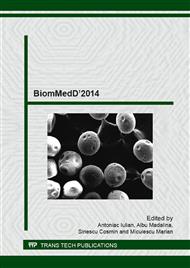p.296
p.303
p.310
p.316
p.322
p.327
p.333
p.339
p.344
Instrumental Assistance to the Restorative Dentistry Treatments
Abstract:
In dental care is necessary to isolate the tooth the oral environment (saliva, tongue, cheek, etc) with some type of retractor. This work aimed to propose a new model of instrumental low cost that assists in dental treatment. The instrumental was virtually designed and tested with the characteristics of the materials used in its manufacture: Solid stainless steel wires of 7 mm, acrylic resin and steel tape. To simulate its functionality was modeled a mouth with the actual measurements via the free software Blender 2.49b. To evaluate the simulation results of the test type black box, where you can observe the operation of the simulator were used. After testing various virtual instruments with the same measurements to assess its performance were made clinically. It was concluded in the simulation and clinical tests that the instrument is stable and performs the removal of anatomical structures adjacent to the tooth, even in cases of patients with positive macroglossia can be used for different types and sizes of arches, in the absence of any tooth can be fixed in any tooth, getting the desired position by professional optimizing the same time.
Info:
Periodical:
Pages:
322-326
Citation:
Online since:
March 2015
Price:
Сopyright:
© 2015 Trans Tech Publications Ltd. All Rights Reserved
Share:
Citation:


